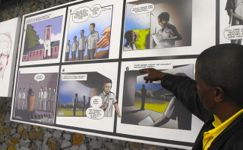Qunu museum gives life to Mandela's legacy
13 December 2013
Tourists have been streaming into the Nelson Mandela Museum in Qunu in the Eastern Cape this week, underlining the institution's worth as a catalyst for the upliftment of the local community - something Mandela insisted on when he opened the facility in February 2000, 10 years after his release from prison.
Situated on a hill top near Mbashe River in his home town of Qunu, the building
honours Mandela's wish that a museum be built at his birthplace to safeguard and
preserve the gifts that he received from all over the world and make them accessible to all South Africans and its visitors.
"Mandela insisted it was not just to be a static collection and tribute to him, but a
living memorial to his values and vision," the museum explains on its website. "It was to inspire and enrich all who visit it, serve as a catalyst for development, and should share the heritage resources linked to him."
The museum's collections and
multimedia exhibitions, including a comic display of
Mandela's life-long struggle for freedom, give visitors insight into the road Mandela
walked to lead South Africa to democracy.
"Through the museum, we promote the values of ubuntu [human kindness] and the
rich history of our country for the benefit of many generations to come," Nokuzola
Tetani, the museum's marketing manager, told SANews recently.
Mandela, who died last week aged 95, is to be buried in Qunu on Sunday, 15
December.
Message of condolence
The number of visitors to the museum has doubled since the former president's death. While the museum usually receives about 100 visitors a day, the number had
doubled since last Friday, Fumanekile Wisani, a spokesman for the museum, said
on Thursday. "There's quite a number of people who are also coming here to write their messages of condolences."
Wisani said visitors were "feeling very sad as they viewed our exhibitions,
but they
were still keen to see those exhibitions, especially the ones about Mandela and
[Albert] Luthuli in conversation". Luthuli was the leader of the African National
Congress and the first South African to be awarded the Nobel Peace Prize.
There was also a lot of interest in the Sisulu exhibition. "We always explain to our
visitors that the role played by Walter and Albertina Sisulu in the life of Nelson
Mandela cannot be forgotten, because they are the ones who welcomed Madiba when he first arrived in Johannesburg."
The stone-and-wood museum in Qunu survived a big tornado earlier this year that
destroyed houses and schools in the area.
Upliftment
According to Tetani, the museum has been central to the socio-economic development of the area since its inception. "The majority of people in this area are poor and unemployed, and what the museum has done and continues to do is to bring business closer. And we always ensure that only
locals are employed where possible."
Since 2008, the museum has been operating on two sites, in Qunu and at the Bhunga Building in nearby Mthatha, which is about 30 kilometres away.
Through its youth and heritage centre, it trains young people in arts, tourism and
farming. Visitors can join a local village tour to experience the authentic landscape of Madiba's birthplace.
Visitors are also taken to the small hut that Mandela slept in during his teenage years in Mqekezweni and shown the remains of his mother's hut in Qunu.
Monde Mgodlana, one of the beneficiaries of the programme, said the museum had
changed his life. "I first started here as a caretaker and moved on to become a tour
guide. I'm grateful for all the opportunities."
Source: SAnews.gov
 Tour guide Monde Mgodlana uses comic panels to tell the story of the former president's life at the Nelson Mandela Museum in Qunu in the Eastern Cape (Photo: GCIS)
Tour guide Monde Mgodlana uses comic panels to tell the story of the former president's life at the Nelson Mandela Museum in Qunu in the Eastern Cape (Photo: GCIS)


